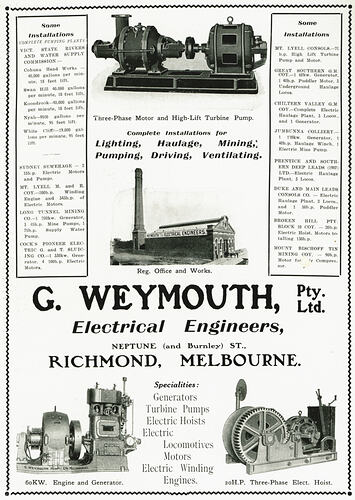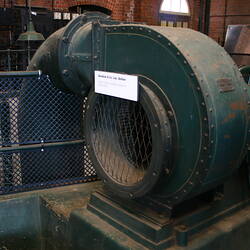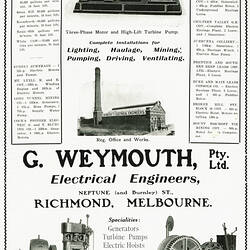The business of G. Weymouth & Co was founded in 1898 by George Andrew Philip Weymouth, who began operating from a small workshop on City Road, South Melbourne (opposite Princes Bridge). An early advertisement describes the firm's activities at this time as being 'makers of dynamos, (electric) motors, x-ray apparatus and electrical instruments, &c' together with 'repairs to every class of electrical work'. George Weymouth was a real pioneer in the field with his business being one of the first in Australia to specialise in the manufacture of industrial electrical equipment. At the time Melbourne's first public power stations had only been operating for a decade, supplying limited electric current for street lighting and a small number of domestic customers. Melbourne had only six electric-powered factories in 1898 and the first application of electricity for motive power in mining, water supply and passenger or goods lifts were 3-4 years off, while the city was to wait until 1906 for its first reliable electric tram service and until 1918 for its first electric trains.
In 1899, George Weymouth moved the business to 225 Little Collins Street, in the central Melbourne, and there was another move in the following year to 234 Little Lonsdale Street, Melbourne (on the south-west corner of Francis Street). There the business would remain for the next eight years undergoing steady growth in both the size, number and variety of electrical equipment produced. Much of the firm's early business centred around the manufacture of small electric motors which found a ready demand amongst the printer's workshops, butchers, clothing & boot manufacturers as Melbourne's manufacturers raced to embrace the clean and convenient new power source.
In 1900, Weymouth & Co won a significant contract to supply a complete electric plant, including a 330 kW generator and four 100 h.p. electric motors, for the Cock's Pioneer Gold & Tin Sluicing Co. at Eldorado, one of the first mines in the state to be electrified.
In April 1901, the business was registered under the Companies Act 1890 as G. Weymouth Proprietary Limited. In November the same year it installed a demonstration electric passenger and goods tramway at the Victorian Gold Jubilee Exhibition in Bendigo, providing public rides on a 2,500 ft (750 metre) track forming a circuit around the grounds, gardens, ferneries and pavilions of exhibition. This experience helped the firm gain contracts to supply electric locomotives for underground haulage in gold mines at Rutherglen and Maryborough and the Mt Bischoff tin mine in Tasmania.
Over the first decade of the 20th century, the mining industry contributed a large share of the firm;s growth with a strong demand for electric generating sets, reciprocating and centrifugal electric pumps, electric elevators, electric hoists & winding engines and electric motors for driving everything from puddling machines to air compressors.
Amongst the more significant early output of Weymouths were: two 15 h.p. electric motors and pumps for the Sydney Sewerage Board; 200 h.p. winding engine and 343 h.p. of electric motors for the Mount Lyell Mining & Railway Co, Tasmania; 200 kW generator, three 45 h.p. electric mine pumps and a 75 h.p. water supply pumping plant for the Long Tunnel Gold Mining Co., Walhalla; 330 kW Generator and four 100 h.p. electric motors for the Cock's Pioneer Gold & Tin Sluicing Co., Eldorado; electric mine haulage locomotives for the Great Southern Gold Mining Co., Chiltern Valley Gold Mining Co., and Prentice & Southern Deep Leads (1907) Ltd, all at Rutherglen; 70 h.p. high-left turbine pump & electric motor for the Mt Lyell Consols Co. and 90 h.p. electric motor for air compressors at the Mt Bischoff Tin Mining Co., Tasmania; 120 kW generator, 40 h.p. haulage winch & electric mine pump for the Jumbunna Colliery; electric haulage plant, mine locomotives and 50 h.p. electric puddler motor for the Duke & Main Leads Consols Co., Maryborough; 20 h.p. electric mine hoist and 130 h.p. of electric motors for the Broken Hill Pty Block 10 Co., New South Wales.
By April 1906, the firm had manufactured a total of 334 electric motors with an aggregate rating of 2,434 horsepower (1,815 kW) - the largest units produced being one 200 h.p. and two 50 h.p. 3-phase alternating-current motors and two 50 h.p. direct-current motors. By the same date generators totalling 1,000 kW had also been manufactured, including polyphase units of 330 kW and 120 kW.
In 1908 the firm moved its manufacturing works into the former power house established by the A.U. Alcock Electric Co in Neptune Street (near Burnley Street), Richmond.
More Information
-
Keywords
-
Localities
Melbourne, Victoria, Australia, Richmond, Victoria, Australia
-
Authors
-
Article types



